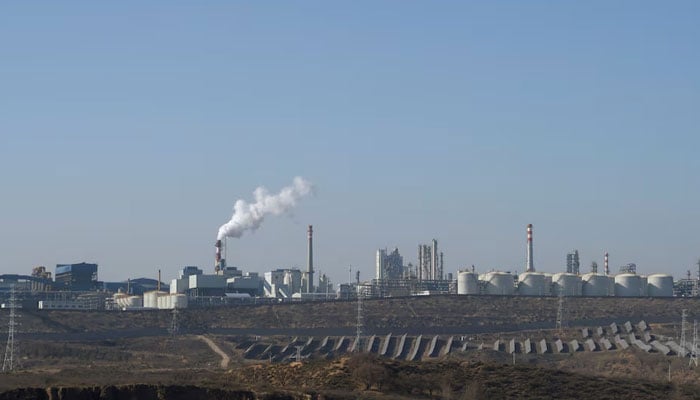China emissions fall 3 per cent in March, may have peaked: report
BANGKOK: China’s carbon dioxide emissions fell in March for the first time since its economy reopened after pandemic restrictions, suggesting the country’s emissions may have peaked, according to a new analysis.
The March drop was the result of expanding renewable capacity, which covered almost all the growth in electricity demand, and a major slump in construction activity. If renewable capacity continues to grow at record levels, China’s emissions may have peaked in 2023, according to the analysis by Lauri Myllyvirta of the Centre for Research on Energy and Clean Air.
Writing for Carbon Brief, Myllyvirta said China’s carbon dioxide emissions fell three percent in March 2024 from a year earlier, based on an analysis of official data.
Emissions for the quarter were still higher, but that was because January and February 2024 were being compared to the still-sluggish period after Covid-19 restrictions were lifted in December 2022.March is “the first month to give a clear indication of the emissions trends after the rebound”, the analysis, published Tuesday, said.
While the March figure is a single data point, it tracks projections from last year and suggests key trends.Power sector emissions stabilised due to increases in solar and wind generation, while steel production dropped eight percent and cement production slumped a massive 22 percent on-year.
That reflects a slowdown in the real estate sector that is likely to continue.The growing uptake of electric vehicles, meanwhile, continues to hit demand for oil, with EVs now accounting for slightly more than 10 percent of all vehicles on the road -- up from seven percent last year, based on sales data.
Crucially, while electricity demand grew -- including at the household level because of air conditioner purchases -- almost 90 percent of the additional demand in March was covered by renewables, Myllyvirta wrote.
Much of that renewable capacity is in the form of small-scale solar, which is increasingly important in China´s renewables surge. Over the first quarter of the year, solar and wind installations were up 40 percent, though there are continued constraints on grid access for new capacity.
-
 Jelly Roll Reveals How Weight Loss Changed Him As A Dad: 'Whole Different Human'
Jelly Roll Reveals How Weight Loss Changed Him As A Dad: 'Whole Different Human' -
 Prince Harry Gets Emotional During Trial: Here's Why
Prince Harry Gets Emotional During Trial: Here's Why -
 Queen Camilla Supports Charity's Work On Cancer With Latest Visit
Queen Camilla Supports Charity's Work On Cancer With Latest Visit -
 Dove Cameron Opens Up About Her Latest Gig Alongside Avan Jogia
Dove Cameron Opens Up About Her Latest Gig Alongside Avan Jogia -
 Petition Against Blake Lively PGA Letter Gains Traction After Texts With Taylor Swift Revealed
Petition Against Blake Lively PGA Letter Gains Traction After Texts With Taylor Swift Revealed -
 Netflix Revises Warner Bros. Deal To $83 Billion: All-cash Offer
Netflix Revises Warner Bros. Deal To $83 Billion: All-cash Offer -
 Prince Harry Mentions Ex-girlfriend Chelsy Davy In UK Court
Prince Harry Mentions Ex-girlfriend Chelsy Davy In UK Court -
 David, Victoria Beckham 'quietly' Consulting Advisers After Brooklyn Remarks: 'Weighing Every Move'
David, Victoria Beckham 'quietly' Consulting Advisers After Brooklyn Remarks: 'Weighing Every Move' -
 Meta's New AI Team Delivered First Key Models
Meta's New AI Team Delivered First Key Models -
 Prince Harry Defends Friends In London Court
Prince Harry Defends Friends In London Court -
 AI May Replace Researchers Before Engineers Or Sales
AI May Replace Researchers Before Engineers Or Sales -
 Christina Haack Goes On Romantic Getaway: See With Whom
Christina Haack Goes On Romantic Getaway: See With Whom -
 Consumers Spend More On AI And Utility Apps Than Mobile Games: Report
Consumers Spend More On AI And Utility Apps Than Mobile Games: Report -
 Aircraft Tragedy: Missing Tourist Helicopter Found Near Japan Volcano Crater
Aircraft Tragedy: Missing Tourist Helicopter Found Near Japan Volcano Crater -
 Taylor Swift Lands In Trouble After Blake Lively Texts Unsealed
Taylor Swift Lands In Trouble After Blake Lively Texts Unsealed -
 'Prince Harry Sees A Lot Of Himself In Brooklyn Beckham'
'Prince Harry Sees A Lot Of Himself In Brooklyn Beckham'




